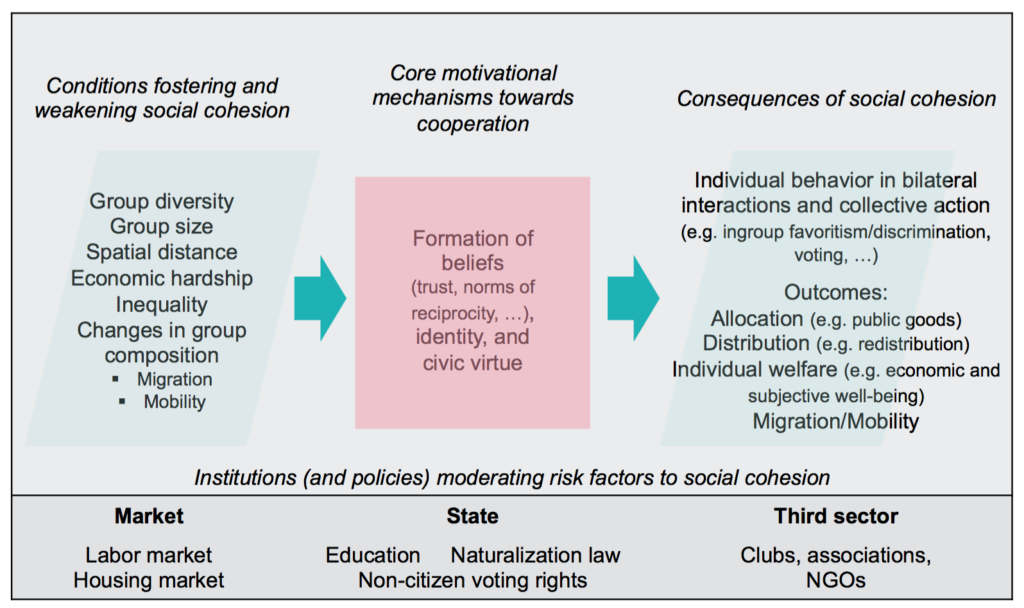Migration, Mobility and Social Cohesion: A Strategic Orientation

Many problems in society can only be successfully addressed if its members are willing to cooperate, even if decisions go against their individual or group-specific short-term interests. This cooperation requires a certain level of cohesion among the members of society. Social cohesion can, therefore, be seen as one of the most fundamental preconditions for human coexistence and high individual welfare. Against this background, the movement of individuals between communities is widely seen to pose a major challenge to cohesion. Scholars across the humanities and social sciences, therefore, engage in the normative and positive study of how social cohesion relates to migration and mobility, characterizing the modern world.
As boundaries of migration and mobility often refer to the nation state, social cohesion and its feared weakening is often seen as intrinsically linked to a challenged nation state. In this short blog contribution, I argue against a conceptualization of social cohesion that is specifically associated with one level of public governance. Instead, social cohesion is critically interconnected to any level of collective decision-making. In this sense, I want to map a strategic orientation of social cohesion in the context of migration and mobility. I consider the developed perspective strategic, as it aims to provide a conceptualization of social cohesion that is specifically tailored to deal with the societal challenges arising from migration and mobility.
A Minimal Definition
In order to work towards a shared construct of social cohesion, I adopt a minimal definition: “A community is described as socially cohesive if individuals are willing to cooperate to solve collective problems involving all its members for non-instrumental reasons.”
This definition emphasizes individual behavior in the form of cooperation. The focus is thus on the characterization of the form of social interaction. In addition, the definition particularly emphasizes inclusiveness, i.e. that cooperation is not restricted to an in-group forming part of the community (potentially at the cost of an out-group). The definition also highlights actors’ motivation to engage in cooperation that goes beyond narrow, short-term self-interest. Furthermore, the definition does neither include the institutional preconditions for social cohesion, nor activities or policies towards cohesion – often termed “integration” in the context of migration and mobility -, nor outcomes related to a cohesive society.

Figure 1. A scheme of social cohesion for societal challenges arising from migration and mobility. Source: Author’s diagram.
Conditions and Consequences
This general definition might form a focal point around which we can organize the key aspects in the study of a society’s cohesiveness in the context of migration and mobility. In particular, its brevity offers a simple opportunity to organize the preconditions and consequences of social cohesion. In Figure 1, I present some factors on the left that might be considered key conditions to fostering or weakening social cohesion. While group diversity and group size characterize static conditions, migration and mobility refer to changes in the group composition and thus characterize dynamic conditions. On the right, some outcomes indicating the wide range of possible consequences of a weaker or stronger social cohesion are mentioned. The dynamics of people being attracted or repelled in response to a more or less inclusive society reveals the bidirectional relationship between migration and mobility on the one hand, and social cohesion on the other. In the center, the core motivational mechanisms towards cooperation are expressed emphasizing the formation of beliefs, identity, and civic virtue. The institutional framework of the nation state, but also any other level involving state actors from the municipality to the supra-national organizations, crucially moderate how the various factors affect social cohesion. Importantly, the institutional framework is defined to include all the humanly designed constraints that work as moderators. In particular, this involves basic labor market and housing market regulations, but also some of the rules for the third sector.
This framework allows structuring and analyzing the challenges and opportunities arising from mobility and migration to social cohesion in the nation state and well beyond. Ideally, the insights productively contribute to institutional change allowing us to foster social cohesion in such an environment.
Alois Stutzer is a Professor of Political Economics at the University of Basel. He is associated with the ‘nccr – on the move’ in the project on “Non-Citizen Voting Rights, Naturalization and Integration. » Among his latest publications are: « Are asylum seekers more likely to work with more inclusive labor market access regulations?« , published in the Swiss Journal of Economics and Statistics (2019).


